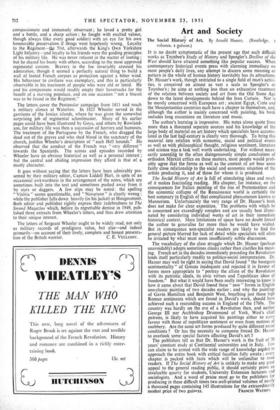Art and Society IT is no doubt symptomatic of the
present age that such difficult works as Toynbee's Study. of History and Spengler's Decline of the West should have attained something like popular success. When contemporary historical events press with alarming immediacy on most people's daily lives, any attempt to discern some meaning or pattern in the whole of human history inevitably has its attractions. Dr. Hauser's work, though restricted to a single field of man's activi- - ties, is conceived on almost as vast a scale as Spengler's or Toynbee's ; he aims at nothing less than an exhaustive treatment of the relation between society and art from the Old Stone Age down to the latest developments behind the Iron Curtain. Nor is he merely concerned with European art ; ancient Egypt, Crete and the Mesopotamian countries each have a chapter to themselves, and, although the author is mainly concerned with painting, his book includes long excursions on literature and music.
The author's learning is impressive. His notes alone quote from more than a thousand separate sources and his knowledge of the large body of material on art history which specialists have accumu- lated in the last haM-century is clearly very thorough. To bring this material into relation with economic, social and political events as well as with philosophical thought, religious sentiment, literature and science was a task well worth undertaking. For without neces- sarily assenting to the often disingenuously simple conclusions of orthodox Marxist critics on these matters, most people would prob- ably agree that the forms as well as the content of art bear some fairly close relationship to the social and economic situation of the artists producing it, and of those for whom it is produced.
The Social History of Art is full of stimulating ideas and much of it makes fascinating reading. His chapter, for instance, on the consequences for Italian pahiting of the rise of Protestantism and the economic collapse of the Renaissance world is certainly the best summary in English of that complicated phenomenon-known as Mannerism. Unfortunately the very range of Dr. Hauser's book does not make for clear exposition. ' The problems with which he is concerned are exceedingly complex and are usually best illumi- nated by considering individual works of art in their immediate historical context. Mere limitations of space have no doubt forced the author to generalise far more than he would have wished. But in consequence non-specialist readers are likely to find the general picture blurred for lack of detail while specialists will often be irritated by what must seem insufficiently subtle discussion.
The vocabulary of the class struggle which Dr. Hauser (perhaps unavoidably) adopts sometimes cloaks rather than clarifies his mean- ing. French art in the decades immediately preceding the Revolution lends itself particularly readily to politico-social interpretation. Dr. Hauser may well be right in saying that David found " the bourgeois sentimentality " of Greuze inadequate and rejected it in favour of forms more appropriate to " portray the allure of the Revolution with its patriotic ideals, its civic virtues and Republican ideas of freedom." But what it would have been really interesting to know is how it came about that David found these " new " forms in English neo-classic painting of two decades earlier ; and why the paintings of Gavin Hamilton and Benjamin West, breathing just those high Roman sentiments which are found in David's work, should have achieved such a resounding success in England of _the 1760s. The country was hardly on the eve of a Revolution then, and neither George III nor Archbishop Drummond of York, West's chief patrons, is likely to have acquired his paintings either to curry favour with those of republican sentiment or even from motives of snobbery. Are the same art forms produced by quite different social conditions ? Or has the necessity to compress forced Dr. Hauser to overlook some special factors affecting David's art The publishers tell us that Dr. Hauser's work is the fruit of 30 years' constant study at Continental universities and in Italy. Few can claim to be armed with the wide range of knowledge needed to approach the entire book with critical faculties fully awake ; every chapter is packed with facts which will be unfamiliar to most readers. If The Social History of Art is unlikely to make any great appeal to the general reading public, it should certainly prove an invaluable quarry for students, University Extension lecturers and sociologists. And a word of praise must go to the publishers for producing in these difficult times two .well-printed volumes of nearly a thousand pages containing 145 illustrations for the extraordinarily


































 Previous page
Previous page